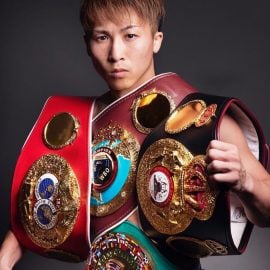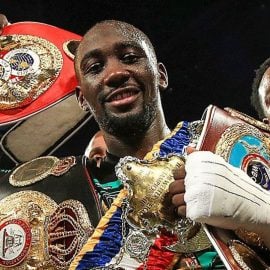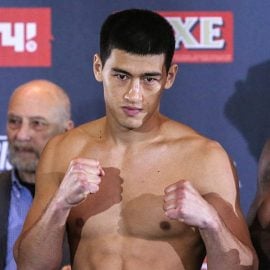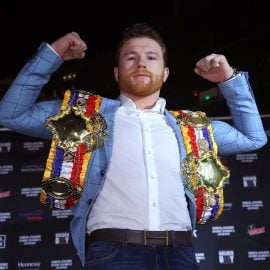Someone’s ‘O’ has got to go: 10 notable fights between unbeaten fighters – Part II

4. June 27, 1988 – Mike Tyson (34-0) KO 1 Michael Spinks (31-0), Convention Hall, Atlantic City, N.J.
In this era of divided titles one truism has repeated itself time and again – arranging a fight that would crown an undisputed champion is a monumental and expensive task. Promoters, managers and TV networks must navigate the equivalent of briar patches, moats, quicksand and electrified fences just to get the proper parties to the table, much less negotiate and/or finalize a deal. One only has to look at the long trail of dream fights that never became reality – Lennox Lewis-Riddick Bowe (as pros), Larry Holmes-Gerrie Coetzee and Floyd Mayweather Jr.-Manny Pacquiao.
 For the second time in heavyweight championship annals, two undefeated fighters with a claim to the undisputed title met inside the squared circle. Mike Tyson, three days short of his 22nd birthday, owned all three major belts and he won them by knocking out Trevor Berbick (WBC) and decisioning James “Bonecrusher” Smith (WBA) and Tony Tucker (IBF). Meanwhile, Spinks owned THE RING’s belt and was considered the lineal titleholder thanks to his two victories over previous lineal champ Larry Holmes. Spinks, the onetime IBF titleholder, was stripped of that belt for prematurely exiting HBO’s title unification tournament to fight a more lucrative bout against Gerry Cooney instead of Tucker, Spinks’ IBF mandatory challenger.
For the second time in heavyweight championship annals, two undefeated fighters with a claim to the undisputed title met inside the squared circle. Mike Tyson, three days short of his 22nd birthday, owned all three major belts and he won them by knocking out Trevor Berbick (WBC) and decisioning James “Bonecrusher” Smith (WBA) and Tony Tucker (IBF). Meanwhile, Spinks owned THE RING’s belt and was considered the lineal titleholder thanks to his two victories over previous lineal champ Larry Holmes. Spinks, the onetime IBF titleholder, was stripped of that belt for prematurely exiting HBO’s title unification tournament to fight a more lucrative bout against Gerry Cooney instead of Tucker, Spinks’ IBF mandatory challenger.
Had Spinks beaten Tucker, he would have been slated to meet Tyson in the final but in the end everyone made out better in a financial sense. Tyson’s purse exceeded $20 million while Spinks’ $13.5 million was more than he had made in 31 previous fights, including his four previous heavyweight title fights.
Tyson’s co-managers Bill Cayton and Jim Jacobs wrangled with Spinks’ promoter Butch Lewis for months only to come up empty. It wasn’t until Tyson stepped in and demanded a deal be done that a deal was done. There also was chaos with the trio of sanctioning bodies. The WBA and WBC each had adopted a 12-round championship limit while the IBF was the lone holdout for the classic 15-round distance. Beginning on July 31, 1987 – the day before Tyson unified the titles against Tucker – the Alphabets agreed to take turns being the lead organization in terms of rules and maximum distance. The agreement was observed without incident for the IBF-sanctioned Tyson-Biggs fight, which was scheduled for 15. It also stood firmly for Tyson’s matches with Larry Holmes and Tony Tubbs conducted under WBC and WBA rules respectively. But once Tyson-Spinks was signed, and when the WBC and WBA realized the IBF would be in charge of boxing’s biggest attraction in years, all hell broke loose.
While the WBA and WBC insisted on a 12-round fight, the IBF initially stood firm on 15 and President Bob Lee issued a series of potential edicts to underline his seriousness. First, he threatened to upgrade the undercard fight between Berbick and Carl “The Truth” Williams from an eliminator to a fight for the vacant IBF belt. Lee also threatened to strip IBF junior middleweight champ Matthew Hilton if he engaged in a 10-round non-title fight on the Tyson-Spinks undercard and to drop Anthony Witherspoon from the IBF cruiserweight rankings if he also fought on the card.
 In the end, Lee never followed through. Hilton chose not to fight on the card while Witherspoon stopped Alex Stanley in five without incident or repercussions. Lee also acquiesced on the 12 round maximum by granting Tyson an exemption under Rule 21 of the IBF constitution, which allowed a champion to become exempt from the regulations by sending in an application to be voted upon by the championship committee. That request had been rejected twice before, but the third time proved to be the charm.
In the end, Lee never followed through. Hilton chose not to fight on the card while Witherspoon stopped Alex Stanley in five without incident or repercussions. Lee also acquiesced on the 12 round maximum by granting Tyson an exemption under Rule 21 of the IBF constitution, which allowed a champion to become exempt from the regulations by sending in an application to be voted upon by the championship committee. That request had been rejected twice before, but the third time proved to be the charm.
And just like that, the fight was on. Finally.
Entitled “Once and For All,” Tyson-Spinks was designed to crown the first undisputed heavyweight champion since Muhammad Ali nearly a decade before. The contrasts couldn’t have been more pronounced. Physically Tyson was a stocky, powerfully built bomber with lightning hand speed and was rated as boxing’s quickest starter due to his 21 victories inside two rounds. Conversely, the 6-2¾ Spinks, considered by many as one of history’s greatest 175-pounders, was three-and-a-half inches taller, owned a five-inch reach advantage and prospered at heavyweight thanks to herky-jerky mobility, professorial intelligence and unconventional combinations. Although capable of scoring the quick KO over overmatched foes, most of the time Spinks needed several rounds to warm up his engine.
A majority of experts picked Tyson to win but more than a few thought Spinks’ boxing skills would befuddle Tyson. Lewis, however, precipitated a long delay when he objected to a knot on Tyson’s hand wraps, which, after an examination by New Jersey State Athletic Commissioner Larry Hazzard, were merely the knotted laces. Lewis continued to raise Cain until Spinks’ chief second Eddie Futch was summoned from the other dressing room and declared the gloves acceptable.
As Lewis left the dressing room, a sweat-soaked Tyson turned to trainer Kevin Rooney and said the following in a menacingly soft voice: “You know, I’m going to hurt this guy.”
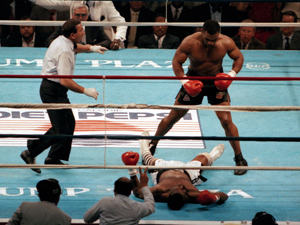 Spinks seemed to know it too, for during his ring walk his face registered nervousness. His fears soon became reality as Tyson charged out of his corner and landed a solid hook within the first 10 seconds. Spinks tried to neutralize Tyson’s rushes with skittered movement but “Iron Mike” sliced the gaps with ridiculous ease. A scorching left uppercut to the jaw and a right to the heart prompted Spinks to take a knee. Up at four, Spinks threw a right that missed while Tyson countered with a side-winding right that put Spinks on his back. This time Spinks couldn’t shake out the fireflies and just before referee Frank Cappuccino’s count of 10 he fell forward through the ropes.
Spinks seemed to know it too, for during his ring walk his face registered nervousness. His fears soon became reality as Tyson charged out of his corner and landed a solid hook within the first 10 seconds. Spinks tried to neutralize Tyson’s rushes with skittered movement but “Iron Mike” sliced the gaps with ridiculous ease. A scorching left uppercut to the jaw and a right to the heart prompted Spinks to take a knee. Up at four, Spinks threw a right that missed while Tyson countered with a side-winding right that put Spinks on his back. This time Spinks couldn’t shake out the fireflies and just before referee Frank Cappuccino’s count of 10 he fell forward through the ropes.
Ninety-one seconds after it began, the world had a new undisputed heavyweight champion and that champion had seized his crown in most destructive fashion. The performance further certified Tyson’s place amongst the pantheon of legendary heavyweight punchers – Sullivan, Dempsey, Louis, Marciano, Liston, Frazier and Foreman. Though Tyson threatened to retire, he would fight on. The same couldn’t be said of Spinks, who walked away from in-ring combat – once and for all.





